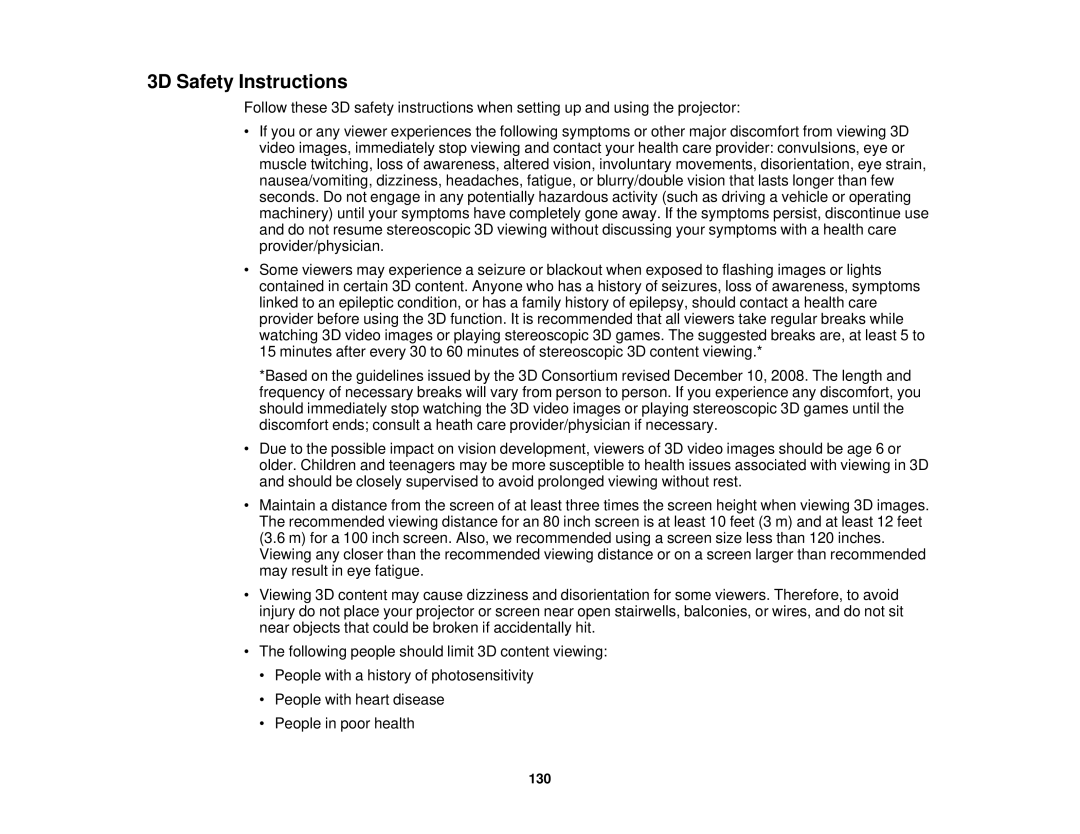3D Safety Instructions
Follow these 3D safety instructions when setting up and using the projector:
•If you or any viewer experiences the following symptoms or other major discomfort from viewing 3D video images, immediately stop viewing and contact your health care provider: convulsions, eye or muscle twitching, loss of awareness, altered vision, involuntary movements, disorientation, eye strain, nausea/vomiting, dizziness, headaches, fatigue, or blurry/double vision that lasts longer than few seconds. Do not engage in any potentially hazardous activity (such as driving a vehicle or operating machinery) until your symptoms have completely gone away. If the symptoms persist, discontinue use and do not resume stereoscopic 3D viewing without discussing your symptoms with a health care provider/physician.
•Some viewers may experience a seizure or blackout when exposed to flashing images or lights contained in certain 3D content. Anyone who has a history of seizures, loss of awareness, symptoms linked to an epileptic condition, or has a family history of epilepsy, should contact a health care provider before using the 3D function. It is recommended that all viewers take regular breaks while watching 3D video images or playing stereoscopic 3D games. The suggested breaks are, at least 5 to 15 minutes after every 30 to 60 minutes of stereoscopic 3D content viewing.*
*Based on the guidelines issued by the 3D Consortium revised December 10, 2008. The length and frequency of necessary breaks will vary from person to person. If you experience any discomfort, you should immediately stop watching the 3D video images or playing stereoscopic 3D games until the discomfort ends; consult a heath care provider/physician if necessary.
•Due to the possible impact on vision development, viewers of 3D video images should be age 6 or older. Children and teenagers may be more susceptible to health issues associated with viewing in 3D and should be closely supervised to avoid prolonged viewing without rest.
•Maintain a distance from the screen of at least three times the screen height when viewing 3D images. The recommended viewing distance for an 80 inch screen is at least 10 feet (3 m) and at least 12 feet (3.6 m) for a 100 inch screen. Also, we recommended using a screen size less than 120 inches.
Viewing any closer than the recommended viewing distance or on a screen larger than recommended may result in eye fatigue.
•Viewing 3D content may cause dizziness and disorientation for some viewers. Therefore, to avoid injury do not place your projector or screen near open stairwells, balconies, or wires, and do not sit near objects that could be broken if accidentally hit.
•The following people should limit 3D content viewing:
•People with a history of photosensitivity
•People with heart disease
•People in poor health
130
